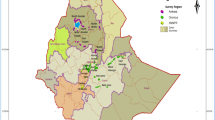Abstract
A two-year survey at Zanjan, Iran, in the 2008–2009 growing season assessed associations of Rhizoctonia root rot (RRR) with 24 cropping system characteristics for disease control purposes. Correspondence analysis evidenced that manure use, sprinkler irrigation, planting beans following potato and tomato, the lack of urea application, proper plant density, shallow planting, avoiding furrow irrigation, manual cultivation, growing Red beans, proper soil organic-matter, weed control using paraquat or bentazon, irrigating at 6–9 days intervals, improving rhizobial nodulation, and growing beans in soils containing 15–30% silt were associated with low RRR spread. Present findings help us to incorporate more effective methods in an integrated RRR-control program for sustainable bean production.
Similar content being viewed by others
References
Altman J & Campbell CL, 1977. Effect of herbicides on plant diseases. Ann Rev Phytopathol 15, 361–385.
Black BD, Russin JS, Griffin JL & Snow JP, 1996. Herbicide Effects on Rhizoctonia solani in vitro and Rhizoctonia foliar blight of soybean (Glycine max). Weed Sci 44, 711–716.
Cull SW, 1975. Physiological studies on trifluralin-induced susceptibility of Phaseolus vulgaris to post-emergence damping-off caused by Rhizoctonia solani Kuhn. M.S. Thesis, University of California, Davis, California.
Dorrance AE, Kleinhenz MD, McClure SA & Tuttle NT, 2003. Temperature, moisture, and seed treatment effects on Rhizoctonia solani root rot of soybean. Plant Dis 87, 533–538.
Gibbons JD, 1976. Non parametric methods for quantitative analysis. Holt, Rinehart and Winston, New York.
Godoy-Lutz G, Arias J, Steadman JR & Eskridge KM, 1996.Role of natural seed infection by the web blight pathogen in common bean seed damage, seedling emergence, and early disease development. Plant Dis 80, 887–890.
Gorodecki B & Hadar Y, 1990. Suppression of Rhizoctonia solani and Sclerotium rolfsii diseases in container media containing composted separated cattle manure and composted grape marc. Crop Prot 9, 271–274.
Grinstein A, Katan J & Eshel Y, 1976. Effect of dinitroaniline herbicides on plant resistance to soilborne pathogens. Phytopathology 66, 517–522.
Gupta SK, Mathew KA, Shyam KR & Sharma A, 1999. Fungicidal management of root rot (Rhizoctonia solani) of French bean. Plant Dis Res 14, 20–24.
Katan J & Eshel Y, 1973. Interactions between herbicides and plant pathogens. Residue Rev 45, 145–177.
Miller De & Burke DW, 1986. Reduction of Fusarium root rot and Sclerotinia wilt in beans with irrigation, tillage, and bean genotype. Plant Dis 70, 163–166.
Miller DE, Burke DW & Kraft JM, 1980. Predisposition of bean roots to attack by the pea pathogen, Fusarium solani f. sp. pisi, due to temporary oxygen stress. Phytopathology 70, 1221–1224.
Naseri B, 2008. Root rot of common bean in Zanjan, Iran: major pathogens and yield loss estimates. Australas Plant Pathol 37, 546–551.
Naseri B, 2013a. Epidemics of Rhizoctonia root rot in association with biological and physicochemical properties of field soil in bean crops. J Phytopathol 161, 397–404.
Naseri B, 2013b. Linkages of farmers’ operations with Rhizoctonia root rot spread in bean crops on a regional basis. J Phytopathol 161, 814–822.
Naseri B, 2014a. Bean production and Fusarium root rot in diverse soil environments in Iran. J Soil Sci Plant Nut 14, 177–188.
Naseri B, 2014b. Charcoal rot of bean in diverse cropping systems and soil environments. J Plant Dis Protect 121, 20–25.
Naseri B, 2014c. Root rot pathogens in field soil, root and seed in relation to bean disease and seed production. Int J Pest Manage 61, 61–67.
Naseri B, 2014d. Sowing, field size, and soil characteristics affect bean-Fusarium-wilt pathosystems. J Plant Dis Protect 121, 171–176.
Naseri B & Marefat A, 2011. Large-scale assessment of agricultural practices affecting Fusarium root rot and common bean yield. Eur J Plant Pathol 131, 179–195.
Neubauer R & Avizohar-Hershenson Z, 1973. Effects of the herbicide, trifluralin, on Rhizoctonia disease in cotton. Phytopathology 63, 651–652.
Osunlaja SO, 1990. Effect of organic soil amendments on the incidence of stalk rot of maize. Plant Soil 127, 237–241.
Phillips AJL, 1989. Relationship of Rhizoctonia solani inoculum density to incidence of hypocotyl rot and damping-off in dry beans. Can J Microbiol 35, 1132–1140.
Porter DM, Wright FS & Powell NL, 1987. Effects of sprinkler irrigation on peanut diseases in Virginia. Plant Dis 71, 512–515.
Riegel C & Noe JP, 2000. Chicken litter soil amendment effects on soil microbes and Meloidogyne incognita on cotton. Plant Dis 84, 1275–1281.
Savary S, Madden LV, Zadoks JC & Klein-Gebbinck HW, 1995. Use of categorical information and correspondence analysis in plant disease epidemiology. In: Advances in botanical research Vol. 21, Incorporating advances in plant pathology. Academic Press.
Schwartz HF & Pastor-Corrales MA, 1989. Bean production problems: Disease, insect, soil and climatic constraints of Phaseolus vulgaris. Centro Internacional de Agricultura Tropical, Cali, Colombia.
Sumner DR, Hall MR, Danny GJ, MacDonald G, Savage SI & Bramwell RK, 2002. Root diseases, weeds, and nematodes with poultry litter and conservation tillage in a sweet corn-snap bean double crop. Crop Prot 21, 963–972.
Valenciano JB, Casquero PA, Boto JA & Marcelo V, 2006. Evaluation of the occurrence of root rots on bean plants (Phaseolus vulgaris) using different sowing methods and with different techniques of pesticide application. New Zeal J Crop Hort Sci 34, 291–298.
Van Schoonhoven A & Pastor-Corrales MA, 1987. Standard system for the evaluation of bean germplasm. Centro Internacional de Agricultura Tropical, Cali, Colombia.
Wrona AF, Vandermolen GE & Devay E, 1981. Trifluralin-induced changes in hypocotyls of Phaseolus vulgaris in relation to lesion development caused by Rhizoctonia solani Kuhn. Phys Plant Pathol 18, 99–106.
Author information
Authors and Affiliations
Corresponding author
Rights and permissions
About this article
Cite this article
Naseri, B., Moradi, P. Farm Management Strategies and the Prevalence of Rhizoctonia Root Rot in Bean. J Plant Dis Prot 122, 238–243 (2015). https://doi.org/10.1007/BF03356558
Received:
Accepted:
Published:
Issue Date:
DOI: https://doi.org/10.1007/BF03356558



